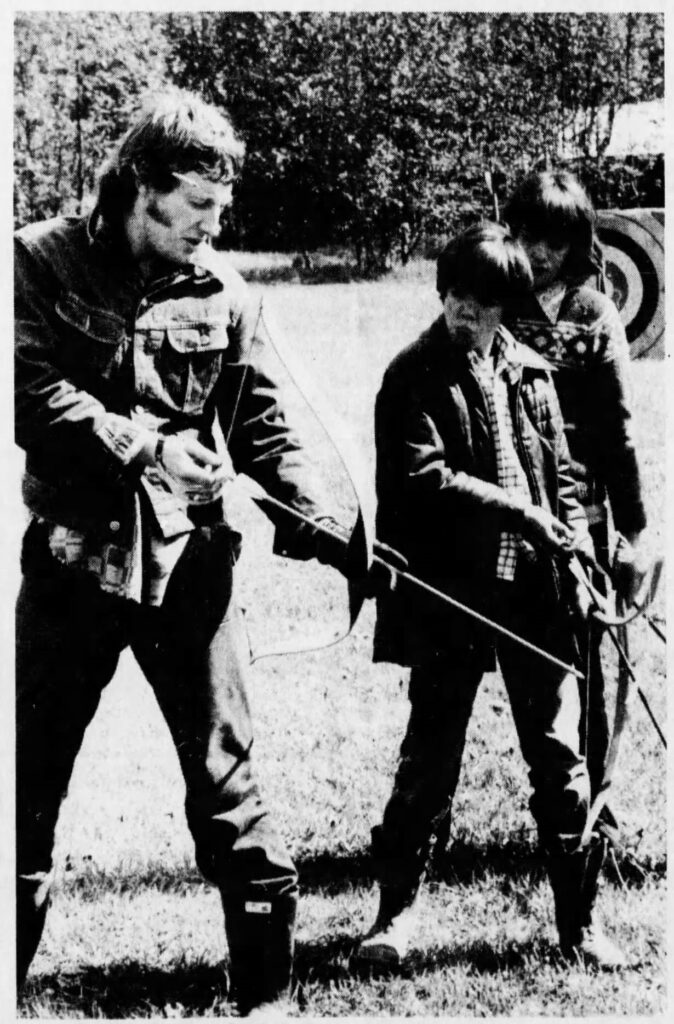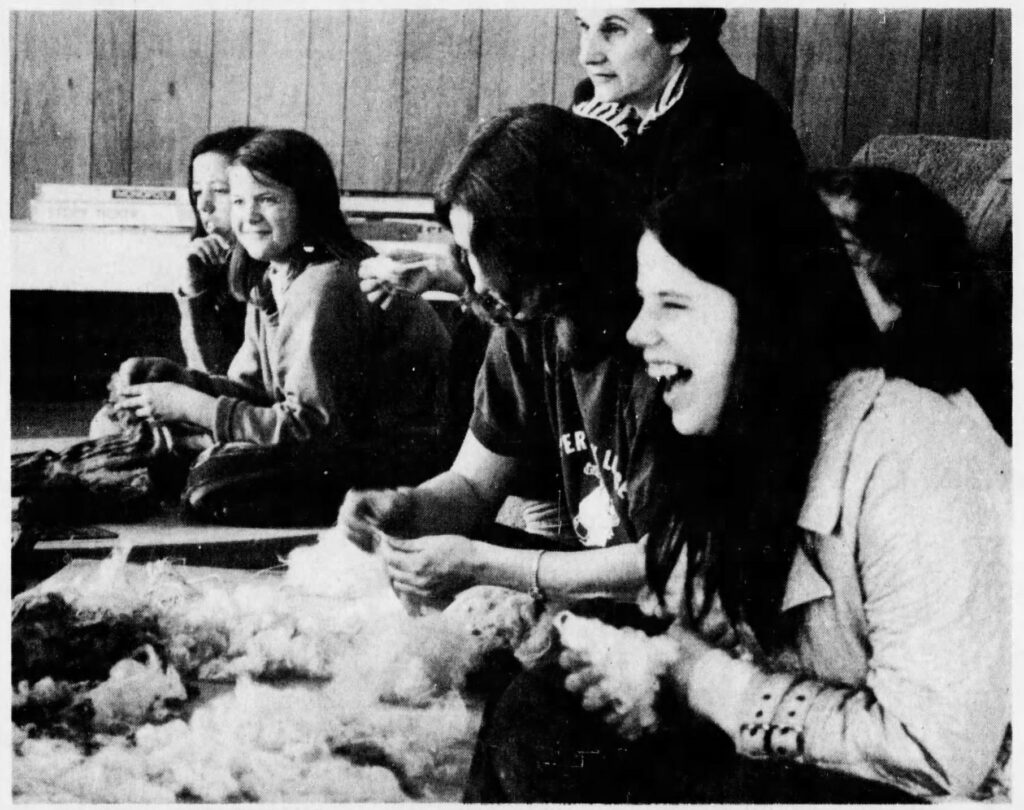Dr. Blank has described the Chilliwack program as one of the three major programs for gifted students in Western Canada.
Chilliwack progress, 1975.
Another section of special education is the enrichment programs. These were one of the positive sides to special education. Chilliwack’s school district could split this into two types; their outdoor education program and their gifted program.
Outdoor Education Program
Because of Chilliwack’s close proximately to nature it was able to start and sustain a pilot outdoor education program. This was a way for students to learn about academic curricular subjects in a more hands on approach. The program was proposed in April of 1973 and by May of that same year the outline and handbooks were finished and approved by the district. The program was held at Columbia Bible Camp in Cultus Lake, and it had an estimated 300 students enrolled between F.G. Leary Elementary School, Little Mountain Elementary School, Sardis Elementary School, and Vedder Elementary School. The students studied plant life like grass, moss, and trees; insects; animals; birds; and even calculated the velocity of streams depending on their grade level. It was a week long program guided by elementary school teachers and university students as camp counsellors. The target age was about 10 to 12 or grades 5 to 6. It mixed real life experience with classroom learning. There were also recreational activities such as weaving, archery, golf, swimming, arts and crafts, motor biking, etc. to help with the physical and social aspects of education. It fostered a real sense of comradery and community amongst the students and their teachers. In October 1973 School District 33 trustees decided to vote to subsidize the program for grade 3 to 7 with a $20,000 budget. By May of 1974 the outdoor education program became a full program running for 4 to 5 days in the spring, and broken down into three subjects: education, recreation, and social development. In August of that same year it was announced that due to the success of the program 700 students would be participating in the program for the coming year. By 1976 the attendance was still at 700 elementary school students participating in the program with 100 secondary students volunteering as counsellors. These large numbers were done in hopes that every elementary school student had a chance to attend the outdoor education program at least once in their academic career.
Gifted Program
Much like the programs geared towards students with handicaps, disabilities, and impairments, the students with exceptional intelligence were seen as needing specialized education in order to promote equal education opportunity to all students. Also like these other special education programs it can be broken down into a timeline of significant events.
– In 1972 students who were seen as exceptionally intelligent or gifted were being recognized by the school district and started to receive special attention as a result. Discussions and studies were being done to figure out a special program for these students to optimize their learning. First they needed to be identified and assessed for their placement. I.Q. was not the only characteristic to determine placement, instead things such as curiosity, verbal flexibility, and development of the final product, academic achievement, originality, self-confidence, and ability to deal with the abstract were used.
– In 1973 the district implemented a program at the fourth grade level designed to find the most effective way to teach gifted children. This program was directed by Dr. Stanley Blank from the University of British Columbia (UBC). The hope was to give answers to questions surrounding educating gifted children. The first year of the pilot program resulted in even more questions that needed to be answered so further research was needed. However it also resulted in gifted student being more eager and interested to learn.
– In 1975 the concept of gifted students being able to “make it on their own” was shifting as the emphasis on the special needs of the gifted students were coming into the spotlight. As the second year of the gifted students’ program was being completed, it was noted by Mel Folkman that although there was a lot of progress there was still a long way to go. Dr. Blank confirmed this sentiment by commending Chilliwack’s program as “One of the three major programs for gifted students in Western Canada,” and describing the first year of the program as an “observing” year. It started with an integrated class and a segregated class, both for the fourth grade level, and during this year moved to three segregated classes, one being the fourth grade again and the other two being fifth grade. There were three main elements to be further fine-tuned: development of the student’s basic learning skills, encouragement of the growth of their productive thinking, and enhancement of their creative potential. The plan for the following year is for teachers to visit these gifted classrooms, and have “in-service sessions” to assist teachers to meet the needs of their students in non-specialized classes. The district also looked to re-introducing integrated gifted classes to see what the best fit for Chilliwack would be. The focus was less on what the program has to look like and more on what the best outcome for the gifted student would look like, as Mr. Folkman could be quoted saying “We are trying for divergent rather than convergent thinking.” Although the program was still rather new and directed at a specific grade level, there was a much larger goal to follow these forerunner students to assess the success or failure of the program and hopefully further develop it to higher grades.
– In 1976 a three-day conference for enrichment and gifted programs, centred on the theme “discovering and enhancing the talents of children: the role of the schools,” was being planned for early February the following year. This was a very significant conference for Chilliwack for two reasons: the first being that Dr. Martin Covington, author of “The Productive Thinking Program” and inspiration for Chilliwack’s gifted program, was going to be the keynote speaker. The second being that Chilliwack’s District not only had representatives attending the conference, but they also had a noteworthy role to play in planning and resourcing the conference. This conference was meant for a means to identify and explore any problems or issues that may arise out of the enrichment and gifted programs in schools, and look at the theories and experiments used to combat them and ways in which to continue developing the programs. The main focus in further development of the programs laid in encouragement of creativity in gifted students to stimulate the “turn-on” phenomenon and thus further facilitate intellectual growth through enrichment in every day learning activities. As this was being planned, Chilliwack’s school district continued to be a pioneer in special education for gifted students. Recommendations were being made and implemented in advancement of the gifted program for continuation of the segregated gifted classes to run from grades 4 through 7 to follow the initial students who piloted the program and to carry on the program for new students joining the program. For the smaller schools “cluster groups” were used in place of classes. The continuation of the program into the junior secondary level was proposed to run in three schools, and keep the students segregated in only the academically necessary subjects such as math, English, science, social studies, and possibly French. Segregation in elective courses was too limiting and impractical. Extra training for the teachers was also being looked at with the continuation and growth of the program. It should also be noted that, as a ground breaker in special education for gifted students, Chilliwack gifted classrooms were being visited by representatives of surrounding areas such as Coquitlam, Langley, Merritt, Mission, Penticton, Richmond, and Victoria.
– In 1977 the “Discovering and Enhancing the Talents of Children” conference was held in Vancouver over the course of three days. Chilliwack’s gifted and talents students program was used as the main model and talking point for the conference due to its success and innovation. A fundamental aspect of this was noted as having teachers that are emotionally secure enough to help foster the curiosity and creativity of the gifted students, handle the criticisms of the public, and have enough sensitivity to understand each student’s specific needs and meet those needs. It was also noted that there were concerns regarding creating an “elitist group of children” due to segregation away from the average students. Although it was argued that this could not happen with elective classes being integrated amongst the student body. As well, academic ability was not the only criterion that established placement. A student could be gifted artistically, physically, or with leadership talents. Also a student did not need to be in the program previously, it was left open for any exceptional student. Dr. Blank commended Chilliwack’s school district on their initiative and went on to emphasize the importance of teaching students to set and develop realistic goals and expectations. He also explained, “The whole community must realize the difference between equal education and equal opportunity for education.” Unfortunately after a year-long trial of having the different schools in district 33 test out their own gifted programs, the segregated approach switched back to an integrated approach of “district classes” because not every school had the ability to maintain segregation. Despite this possible setback to the gifted program, plans to further develop it up to the junior secondary grades were still under way to follow the initial pilot students and the success or failure of the program. This junior secondary section of the program is being split up between two schools on either side of the highway, Chilliwack Junior Secondary School and Vedder Junior Secondary School, to greater accommodate the population of Chilliwack.



